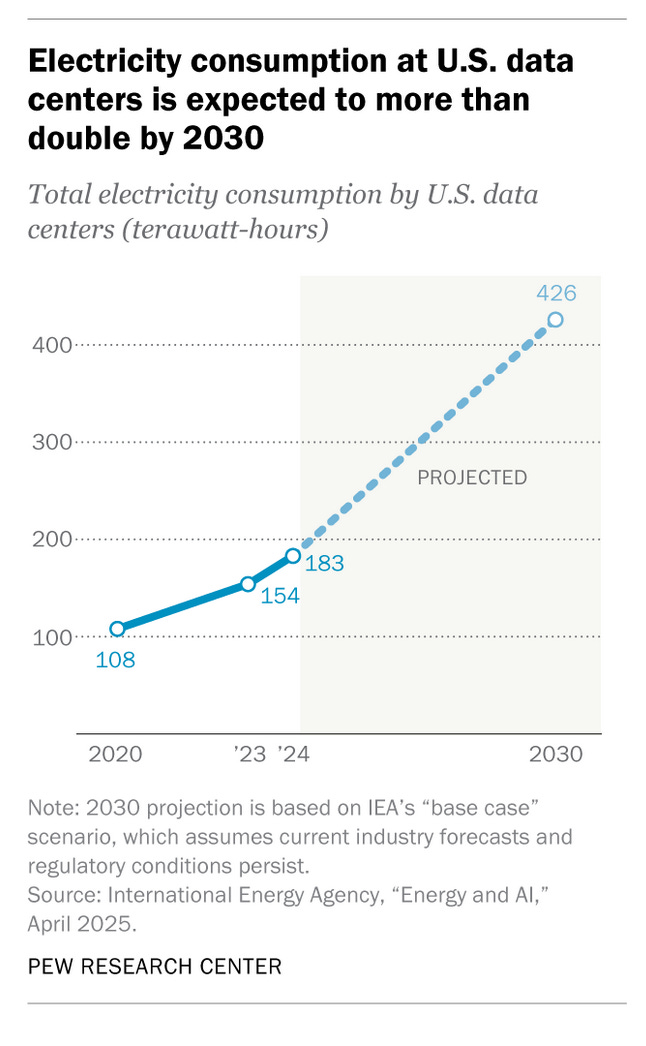Weekly Grounding #119
News, links, writing
Weekly Groundings are published every Friday to highlight the most interesting news, links, and writing I investigated during the past week. They are designed to ground your thinking in the midst of media overload and contribute to Handful of Earth’s broader framework. Please subscribe if you’d like to receive these posts directly in your inbox.
If you’re already subscribed and want to help the publication grow, consider sharing Handful of Earth with a friend.
“How MAGA Trumped Neoliberalism”
At Unherd,
analyzes the new global economic order. He argues that the “dissatisfaction, as well as a peculiar ideological mélange, that Trump defined is not going to go away: regardless of what happens to the man himself. Individuals certainly matter in history, but deep economic and political currents matter at least as much. After four years of Trump’s first presidency, policies that, in the beginning, appeared unusual, have been adopted by the rest of the body politic. They remained, and were even developed, after his first term. Thus the new political and economic order is already here. Trump’s second administration is continuing along the same path, and even accelerating the change.”“A new set of political beliefs, unrelated to whether Trump is in power or not, has been created, and is likely to remain long after he is gone,” Milanovic contends. “One can see this clearly by listing four areas that are each in direct opposition to neoliberal ideas. First: instead of globalisation, there are tariff wars and economic exclusion zones. Second: instead of economics being insulated from politics, there are politically motivated sanctions and state-led industrial policies. Third: instead of the aspiration to full mobility of people around the world, there are walls and fences. Fourth: instead of cosmopolitanism, as a desired ideology, there are openly nationalistic movements in positions of power.”
Milanovic concludes with a twentieth-century historical comparison: “Socialism shorn of its internationalist component produced national socialism in its Hitlerite and Stalinist versions. Global neoliberalism shorn of its internationalist component gives us a vision of the new emerging consensus: liberal policies limited to national markets and mercantilism abroad. This also, I believe, convincingly proves that the critics of the new consensus are wrong to call it ‘fascist.’ Yes, it shares a nationalistic element with ‘fascism,’ but not more so than mercantilist policies in general. Domestically, though, it eschews any socialistic element—nay, it explicitly rejects them—and in that respect it comes close to, or is indistinguishable from, neoliberalism.”
For more on this topic, see my 2024 article, “We Are All Trumpians Now.”
“Democrats Are Locked on Campus”
At The Financial Times, Edward Luce writes that “For years it has been common in liberal circles to blame Donald Trump’s success on the electorate’s deplorable prejudices and dismiss the idea that economics plays any role in how they vote. But in an autopsy published this week on Trump’s 2024 victory, a group of centrist Democrats called Welcome, made it plain how self-defeating this has proved. The report, ‘Deciding to Win,’… lays out how their party has been steadily losing non-college voters of every race, creed and colour since Barack Obama’s re-election in 2012.”
Drawing on the report, Luce notes that “Since 2012, the word count in the Democratic party platform about specific racial groups rose 828 per cent, of LGBTQ rights by 1,044 per cent and the word ‘hate’ by 1,323 per cent. Mention of the middle class fell by 79 per cent, ‘men’ by 51 per cent and ‘fathers’ vanished altogether. In politics, you are what you talk about. The report notes that many of the policies that Democrats have championed—open borders, defunding the police, rights for trans people and climate change—are unpopular with blue-collar voters of all races. Contrary to what is often believed, Joe Biden did not prove to be an exception to that rule. He campaigned as a centrist but embraced the progressive agenda after he took office.”
“A Big Night for Democrats”
Despite the Democrats’ systemic policy and messaging issues, this Tuesday’s election was a clear boost for an otherwise floundering party. At The Liberal Patriot,
, , and analyze initial voting patterns. Baharaeen writes that “Democratic voters are fired up. This energy produced several big wins for the party, including in races for New Jersey and Virginia governor, the Virginia House of Delegates, the Pennsylvania Supreme Court, and the Georgia Public Service Commission. There was nary a bright spot for Republicans last night. Democrats’ success came in no small part thanks to many Americans’ displeasure with President Trump’s performance so far in his second term.”However, Baharaeen notes that Democratic Party “victories in New Jersey and Virginia were powered by college-educated voters, while working-class voters, who are overrepresented in the national and battleground-state electorates, remain steadfastly against them.” Continuing on this theme, Teixeira observes that the “strong performance among the college-educated continues to be the Democrats’ hole card, especially their strength among white college women. Compare Democrats’ performance among this group to their performance among other white gender/education groups in Virginia and New Jersey. White college-educated women are clearly dwelling in a different political universe than the other groups.”
“What Happened When Small-Town America Became Data Center, U.S.A.”
The Wall Street Journal reports on the rapid construction of data centers to fund the expanding cloud and AI economy: “America’s tech build-out has minted millionaires in Silicon Valley, helped a record-breaking stock market defy gravity and buoyed an otherwise uncertain U.S. economy. Investment in software and information-processing equipment drove most of America’s GDP growth in the first half of 2025, according to federal data. The top five tech giants—known as hyperscalers in the data-center world—total more than a third of all S&P 500 capital expenditures.”
“Companies are throwing money at digital innovation to become more profitable with fewer workers down the road,” the article continues. “But the sheer scale of investment has obscured how it is already reshaping America, in the form of windowless buildings the size of multiple football fields where businesses store and process information. That development is injecting vast sums of cash into sometimes unexpected corners of the country—many of them bypassed by previous boomtimes.”
“Fears that construction could peter out haven’t deterred towns from tethering their fortunes more tightly to the corporate spending sprees and stratospheric Wall Street valuations that are fueling talk of a bubble. In…Hermiston, Ore., where small armies of workers recently toiled at two data-center sites ringed by barbed-wire fences, officials are trying to annex land for additional development in a bet the boom will continue. ‘We’re open for business,’ said Mark Morgan, assistant city manager in Hermiston, whose roughly 20,000 residents make it the largest community in the region. ‘If this is what’s going on right now,’ he said of data-center development, ‘this is what it’s going to be.’”
“Amazon reports it injects billions of dollars annually into the Oregon economy,” the article reports…[Amazon Web Services] pegged the current number of employees and contractors across Umatilla County—a Puerto Rico-sized area home to about 80,000 people—at the equivalent of 3,200 full-time workers. If construction ever slows, that will dwindle. The small number of permanent jobs may be a feature, not a bug, for some residents who treasure their communities’ small-town feel. ‘We were a town where everybody knew everybody,’ said Dennis Barnett, a Hermiston accountant and benefactor of its rodeo. ‘Now, I know nobody.’”
“What We Know About Energy Use at U.S. Data Centers Amid the AI Boom”
Pew Research Center provides an overview of data center energy use in the United States: “Since data centers are often geographically concentrated, they can significantly strain the power grids. In 2023, data centers consumed about 26% of the total electricity supply in Virginia and significant shares of the supply in North Dakota (15%), Nebraska (12%), Iowa (11%) and Oregon (11%), according to the Electric Power Research Institute.”
“Utilities often must make expensive upgrades to power grids so they can handle increased energy demands from new data centers,” the report continues. “Smaller businesses and U.S. households often shoulder these costs unless ratepayer protections are put in place. For example, in the PJM electricity market stretching from Illinois to North Carolina, data centers accounted for an estimated $9.3 billion price increase in the 2025-26 ‘capacity market’ (i.e., the total amount of electricity that providers in the region commit to supplying). As a result, the average residential bill is expected to rise by $18 a month in western Maryland and $16 a month in Ohio.”
“Americans may see more widespread price hikes in coming years. One study from Carnegie Mellon University estimates that data centers and cryptocurrency mining could lead to an 8% increase in the average U.S. electricity bill by 2030, potentially exceeding 25% in the highest-demand markets of central and northern Virginia.”
“Why Every Family Needs a Code Word”
What is all this energy being used for? One rapidly developing AI application is audio deepfakes that mimic real peoples’ voices for fraudulent purposes. The Wall Street Journal casually recommends that all families have a “code word” in order to verify the identities of close relatives on the phone.
“People who haven’t implemented a family code word have been burned by bad actors. I wrote earlier this year about a Colorado woman who received a call from a young woman who she said sounded just like her daughter. Only after wiring $2,000 to protect her daughter from danger did she learn the whole thing was a scam. It’s easy to see how someone can be fooled. My colleagues recently created deepfakes of several Wall Street Journal staffers’ voices, including my own, and it was hard to tell the human voices from the clones.”
AI researchers have been talking about deepfakes for a long time, but the recent advances in synthetic audio have made this problem even more serious than earlier advances in visual deepfakes. This is likely a harbinger of the increasingly weird social effects of generative AI to come. The Journal presents this as something we just all need to adapt to, calling the family code word a “simple solution” to a “high-tech problem.”
What grounded your thinking this week? Share in the comments.





